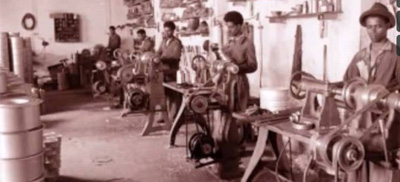
Compiled and researched by Resoum Kidane

Compiled and researched by Resoum Kidane
Historically the Eritrean working class emerged with the advent of the Italian colonialism in the late 19th century. In the earliest period the colonisation was aimed at getting access to the natural resources of the country, cheap labour, and securing farmland for Italian settlers. To realize these objectives, the colonial power in the first decade concentrated on expropriation of land from indigenous owners to allot it to the new Italian settlers.
There were some resistance from the local chief Bahta Hagos who used to administer one of the regions in Akeleguzia expressed his opposition and compelled them to reconsider their actions. In 1903, the Italians adopted a new law which enabled the Italians to take over all farm plots in eastern and western Lowlands and all the confiscated fertile land from the indigenous owners which might have less resistance to the law. The Italian administors coined the name “land of Domenya”to distribute to the Italian settlers (Woldeyesus,(2001)
Woldeyesus,(2001) states that the Italian farmers introduced modern farming methods in the country where many of the local Eritreans were employed in the plantations as daily labourer. By 1909, as a result of confiscated fertile land thousands of Eritreans were denied to farm their land and become wage labourers on their ancesteral land. The confiscated farm plot for fruits and vegetables farming, as well as cotton and coffee plantation and dairy farming gave more opportunity for Italian settler farmers to become wealthy. .During those years the Italian colonialism also established the following towns Sabur, Elaberid, Halhale, Dekemhare and Ghinda for the colonial settler farmers.
Ghinda in 1932 
During the first decade of colonialism, the colonial administration also launched infrastructure development projects including ports, roads, telecommunications and factories. According Zere (2013) as soon as the Italians declared Eritrea their colony, their skills and strong with no reservation were deployed buildling residential villas, roads, railways, bridges and tunnels, etc. using the armed forces and/or low-paid Eritrean labour force.
The first infrastructure of road between Massawa and Saati was constructed in 1887, then continued to Ghinda and reached Asmara in 1909. The Keren line Asmara-Keren of 104, Keren-Agordat of 86 was begun in 1910 and finished in 1922. All the constructions were undertaken through hiring many natives from different parts of the country.Woldeyesus,(2001)
Dira, 2004, stated that ascari (local military recruits) played important roles in the construction infrastructures. It is worthy to note during those major developments projects in the communication and transportation aspects of the country, many Eritreans died in the construction sites particularly around the Arberebue area (zigzag route of Asmara-Massaw)for lack of work site safety supports and the harsh environments.
Arberebue area (zigzag route of Asmara-Massaw)
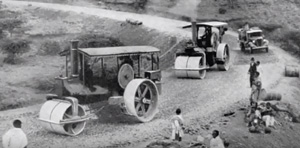
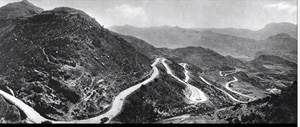
source Costruzione della strada Asmara- Massawa
In 1920 the first aeronautical infrastructures were also built in Massawa and Asmara for military purposes and employing military manpower, ]following] thereafter other airports was opened in Keren, Agordat, Barentu and Thi’o (Vitale 1960: 158-159 cited by Uoldelu (2004). General speaking major transport and communication networks particularly the railways which were planned to serve the quick and effective deployment of troops over the territory not for use by the Eritrean people.
Following the establishment of new transportation and communication methods in the country, the Italians also started to set up new factories. By 1939, around 2,198 small scale factories were in operation which employed thousands of Eritreans
The newly opened factories produced buttons, cooking oil, and pasta, construction materials, packing meat, tobacco, hide and other household commodities. Most of these firms were located in urban areas such as Asmara, Dekemhara, Massawa and other towns which became one contributing factor for a migration of the rural population towards the urban centres to work in companies and other services. Among the rural population many also worked on agricultural plantations or for companies in their local areas as daily labourers. Most of them worked for low wages or as free labour for Italian employers.
Daily labourers
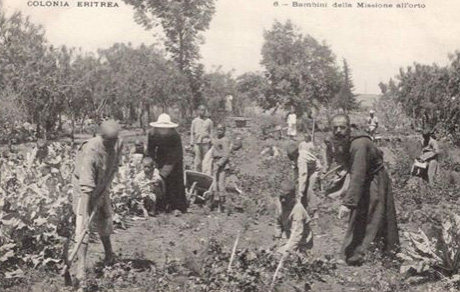
Photos from the archives of the Catholic Mission in Eritrea (1900s - 1920s) source Vintage Eritrea
During the Italian colonization the working class were not only exploited by their employers but also became victim of the Italian colonial discrimination over salaries. According NCEW salaries for indigenous workers were low compared with that of the Italian workers such as Sicilians. Generally during this era, the Eritrean workers were subjected to appalling working conditions, low pay, discriminatory labour laws, long hours of work, and above all they were deprived of improving their skills and educational opportunities. NCEW)
Unequal wages for Eritrean and Italian workers
Yemane AbrahaEritrea Architectural History in Pictures
The development and expansion of industries, trades and agricultural plantations across the nation were greatly contributed by the increase in working class as well as growing of urban areas. Regarding the genesis and development of urban areas Singh states that the growth of small towns started with construction of various communication infrastructures, development of horticulture irrigation schemes, exploitation of mining and the setting up of factories. Asmara was planned on the pattern of Rome as the capital and industrial town while Massawaand Assab were planned as port towns. Mendefera and Keren were planned as military garrison centers. Dekemhare was planned on the pattern of Milano as industrial center and Gura was planned as an airport The construction of magnificent buildings like town halls, cinema halls, hotels, places theaters, factories, markets and commercial complexes in Asmara and other towns were built by Eritrean labourers,
Cheap Eritrean labor was exploited by Italy to fulfill its own need
s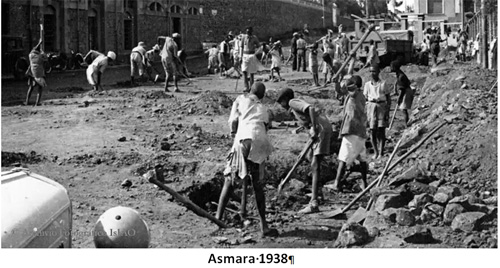
In the late 1930s the city of Asmara had a population of 98,000, of which 53,000 were Italians according to the Italian census of 1939. This fact made Asmara the main "Italian town" of the Italian empire in Africa (Wikipedia). As can be seen from a table below, the number of Italians residing in the country increased from 1000 to 76,000 between 1910 and 1939 respectively.
| Year | Italian Eritreans | Eritrea population |
|---|---|---|
| 1910 | 1000 | 390,000 |
| 1935 | 3100 | 610,000 |
| 1939 | 76,000 | 740,000 |
| 1946 | 38,000 | 870,000 |
| 2008 | 900 | 4,500,000 |
In 1935 the Eritrean population was also estimated to be around 600,000 (Tekeste Negash 1987: 51, cited by Dira). Out of 600,000 there were 130,000 Eritreans served in the Italian colonial army between the years 1890 and 1935 reaching the highest point of roughly 60,000 during the campaign for the invasion of Ethiopia in 1935 (Killion 1998: 91) Generally, the large number of conscriptions to the Italian army became the main factor for the increase in rural -urban migration. The massive enrolment of conscripted Eritreans (ascari) had a significant impact on the development of urban centres, not only in quantitative but also in qualitative terms (Dira, 2004
In 1908 Asmara was divided into four areas: the first was exclusively reserved for Europeans, the second was mixed (Europeans and Africans), the third was for indigenous people and the fourth was destined to suburban homes (later it was assigned to the industrial area) Podest,(2011).
Third part of Asmara where was located for indigenous people to live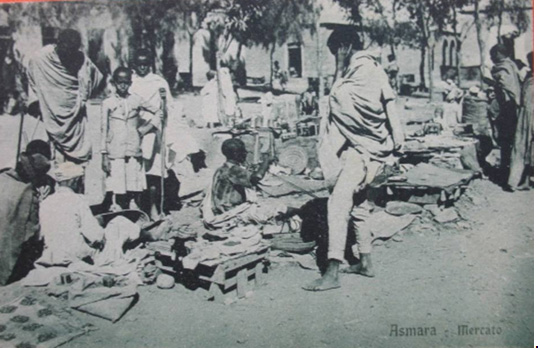
Asmara local market (ca 1920s/1930s)
The residential segregation exacerbated in the 1930s when Italy declared a proclamation deliberately designed to discriminate between the native blacks and the white colonizers. Despite the fact that magnificent buildings in Asmara were constructed by Eritrean labour, they were forced to use separate public transport, restaurants and bars, as well as residential areas. They were not allowed to access places that were reserved for the whites. Zere (2013) also states that in the city the restriction most resented was not being allowed to walk through the main thoroughfare which the locals call Combishtato, a beautiful and super modern Boulevard.
Combishtato (the main thoroughfare) in 1930s
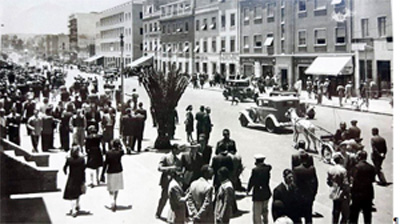
Many locals did not care and started walking in defiance but paid the price in imprisonment and torture. Furthermore during the Italian fascism period only 6 out of the 25 schools for Eritreans provided basic literacy and vocational training up to 4th grade apart from the Scuola Vittoria Emmanuel in Asmara. Kibreab (2005:95) also points out that the total number of Eritreans who received education between 1894 and 1940 was only 20,000. This figure indicates that there was no opportunity for young Eritreans either to get access to basic education or to pursue their education to higher levels.
Consequently, the only choice the Eritrean citizen had was either to be conscripted into the colonial army or work in domestic service, road constructions, street, agricultural sector; translation etc. During Italian colonialism the large number of conscription to the Italian army, the increase in the number of Eritrean workers and others such as housemaids, translators, clerical workers etc significantly contributed to the Eritrean population being urbanised. According to Killion (1995) 20% of the Eritrean population was urbanised was unusual for this region of Africa in the colonial era as compared to, for instance to Tanzania where only 7% of the population lived in urban areas.
Education prior to fascism
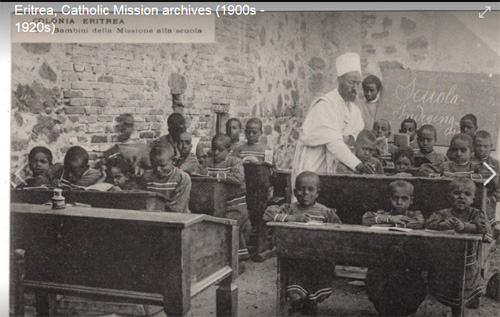
Photos from the archives of the Catholic Mission in Eritrea (1900s - 1920s) source Vintage Eritrea
As part of the segregation policy, the fascist Italian regime also banned educational opportunity for Eritrean citizens and access to education was limited to only up to Grade 4 Additionally, Italy officially also declared that whites are above the law and Eritrean do not have equal rights to whites. Source Woldeyesu(2009)
Eritrean natives have no equal rights as whites.
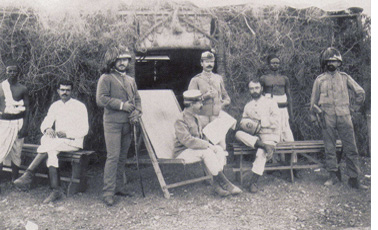
Under colonial racism [under] during fascism one of the rules of segregation was to serve the ascari/conscripts tea or other beverages in recycled soup cans and not in glass or ceramic cups. For some reason this offended the conscripts more than anything else. Many conscripts took the hot beverage served in recycled soup cans and splashed it in the face of any Italian they encountered. Those who were caught were summarily hanged or shot. Many Italian soldiers’ heads were also cracked some even died by stones thrown at night or while hiding. (Zere, 2013 )
There were also isolated worker protests against the foregoing injustices all over Eritrea, though Eritrean workers were prohibited by law to organize and protest against these incredible injustices. As a result of protests many Eritrean workers were detained, hanged and some exiled to NAKHRA (an island prison of the Assab Port)..NCEW .
From then on the Eritrean people started to see the Italians as enemy. Consequent[ly of] to the defection of thousands of ascari, the protest of workers and a patriotic resistance to Italian rule in Eritrea, British forces were able to defeat the Italian army in the Horn of Africa in 1941.
Generally the Italian colonizers developed all communication infrastructures, towns, factories and school buildings not for the benefit of Eritrean people but for the sake of their own interests, as they thought their stay was forever.
An overview on Post Italian colonialism and condition of working class
After the Italians defeat[ed] in 1941, the growth of light industries and communication infrastructure also continued due to Eritrea’s strategic importance for American and British military operations in the region.
According Makki (2011) The Eritrean port of Massawa with its natural harbour and serviceable installations emerged as an attractive option. Joint Anglo–American plans were drawn up to establish war-related industries and services, and work on the various projects started in earnest in the winter of 1941.
By the spring of 1942, the Americans had set up an aircraft assembly plant, a centre for repairing aircraft engines, and a naval base in Massawa that served as a shipping repair station. The British navy installed a major ammunitions store in an Italian-built underground depot and the British Overseas Airways Corporation (BOAC) erected a repair and maintenance shop in Asmara. Two British military hospitals were rapidly constructed on the plateau and the establishment of war-related projects considerably boosted the local light industrial sector. In the summer of 1942, Eritrea appeared set to become the main base for the Allied war effort in the Middle East. But these frenzied preparations proved short-lived.
This development ceased after WW II and a number of factories were closed down. Unemployment was exacerbated further when the British administration in Eritrea removed such as the Asmara-Massawa Cableway [were successively removed and] which was sent to India and to British possessions in Africa as war booty.[27]. It was estimated £86 million East Africa Shillings worth of industrial plant & equipment, including port facilities were removed by British Military Administration.
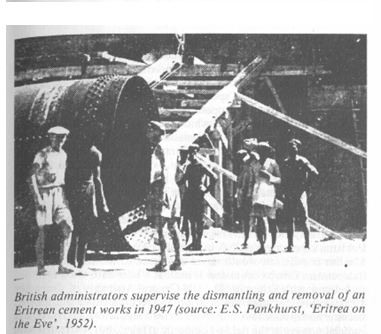
In 1944-45 there were 1,610 medium and small-scale factories in operation but [later] 636 workshops and small scale enterprises were closed in 1948. This may have been the result of the British Military Administration’s policy of dismantling Eritrean infrastructure and factories. According to Mussei (2011) small enterprises were also closed down because of lack of raw materials and the draining away of hard currency reserves. As a result of enterprises closing, Mussie estimates the number of unemployed Eritreans reached 10,000 out 14,000 and only 5,600 out of 35,000 Eritrean workers managed to keep their jobs, in 1948 and 1949 respectively (Mussie 2011, Mesfin 2017)
Here is an excerpt , from the article "Culture and agency in a colonial public sphere: religion and the anti-colonial imagination in 1940s by Fouad Makk, Social History, 36:4, 418-442, 2011.
1942, Eritrea appeared set to become the main base for the Allied war effort in the Middle East. But these frenzied preparations proved short-lived. By the end of the year, following British victory over German forces at the Battle of El Alamein, the tide of war in North Africa shifted and the various war-related projects in Eritrea came to an abrupt halt.
American personnel were withdrawn and Egypt once again became the main Allied base. Most of the existing projects were dismantled, and in a callous sabotage of Eritrea’s infrastructure and economy the British removed or sold abroad not just the new installations but some of the Italian-era structures as well, including port facilities and the ropeway connecting Asmara to Massawa, which was the longest ropeway in the world at the time. In Massawa alone, ‘some buildings – customs offices, warehouses, dwellings of naval and civil officials and personnel, the quarters of passengers held for quarantine – had been demolished’.
The cement factory on the peninsula of Abdulkadir, which used to produce 1000 tons of cement daily, was sold to an Englishman who in turn dismantled and sold it to businesses in British-occupied Sudan. Even the large new hospital in Massawa was demolished in order to sell the building materials abroad. Thousands of workers lost their jobs and most were unable to find employment.
In addition, a large number of demobilized askarii colonial conscripts lost access to waged income as well as the pensions to which they were entitled for service in the colonial army. These mounting hardships were aggravated by the blatant disparity in British treatment of Italians and Eritreans that led to a kind of white trades unionism between the British officials and Italians, whereby certain classes of clerical or other appointments were invariably filled by Italians despite the presence of equally well qualified native employees; whereby native employees doing the same work as Italians were paid less; and whereby Government contracts which could have been carried out by natives were given exclusively to Italians ( Makki , 2011)
To conclude during the post-WW II depression the large scale unemployment and work related discrimination contributed to the growth of political consciousness among Eritrea's urban working class which led to several labor incidents prior to 1950 which will be briefly discussed in the next section.